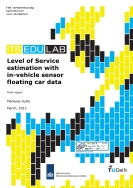To improve traffic conditions and safety, a large number of traffic management applications are being used in daily practice. These traffic management applications need information on the prevailing traffic conditions to adequately function. To obtain these, traffic sensors are used. Traffic can be monitored through a large range of different traffic detectors. These detectors are often quite inaccurate and costly. In the Netherlands, induction loops are the most widely used traffic sensors. The Smart In-Car project offers the possibility to investigate a new type of traffic monitoring. In this project, the values from several in-vehicle sensors, obtained from the CAN (Controller Area Network) bus, and the GPS positions are collected with the uCAN on board unit from a small number of equipped vehicles.
The objective of this research was to determine if Level of Service (LOS), a categorical qualitative description ranging from A to F of the traffic conditions on a road, defined by the density, can be accurately estimated with in-vehicle sensor floating car data. In-vehicle sensor floating car data is defined as the CAN bus data which is collected with the uCAN on board unit. Plain floating car data is defined as exclusively the positional data (provided by the GPS unit of the uCAN on board unit) of the equipped vehicles. Since the number of equipped vehicles is very limited, the real CAN bus data set is only suitable to assess the LOS estimation with single vehicles. To assess the LOS estimation of in-vehicle sensors with multiple vehicles at various penetration rates, traffic simulation data, containing vehicle trajectories and loop detector data, is used. In the simulation, not only detection point data is used to determine the LOS ground truth, but also the actual density, determined with the vehicle trajectory data. Using the simulated CAN bus data, the LOS is also estimated with single vehicles, to be able to compare the results with the real CAN bus LOS estimation.
From the real CAN bus data set, the data points of vehicles passing a loop detector location are combined with the respective loop detector data. The loop detector speed and intensity data are used to determine the LOS ground truth at the time and place of the vehicle passage. A correct LOS estimation rate of 37% is found. First, the simulation data is used to assess the LOS estimation accuracy with single vehicle passages, as is done with the real CAN bus data. The determined correct LOS estimation rate is 52%. Secondly, the LOS is determined using the simulated CAN bus signals of multiple vehicles, for different penetration rates. The found correct LOS estimation rates range from 52% at 1% penetration to 70% at 100% penetration. Finally, the LOS at different penetration rates is also determined with the simulated data using just the vehicle positions, to simulate plain floating car data. For this method, the correct LOS estimation rate ranges from 39% at 1% penetration to 100% at 100% penetration. The results show that in-vehicle sensor floating car data generally provides a less accurate LOS estimation than plain floating car data.
Based on the results, it is concluded that it is not possible to accurately estimate the Level of Service with in-vehicle sensor floating car data. This conclusion relates to, and is only valid for, two-lane motorways with a 120 km/h speed limit and the CAN bus signals which were available in the data set, since only that road type and those CAN bus signals where considered in this research. It is recommended to investigate the CAN bus signal usability for other use cases. The wealth of information offered by the CAN bus signals offer possibilities for many applications.
